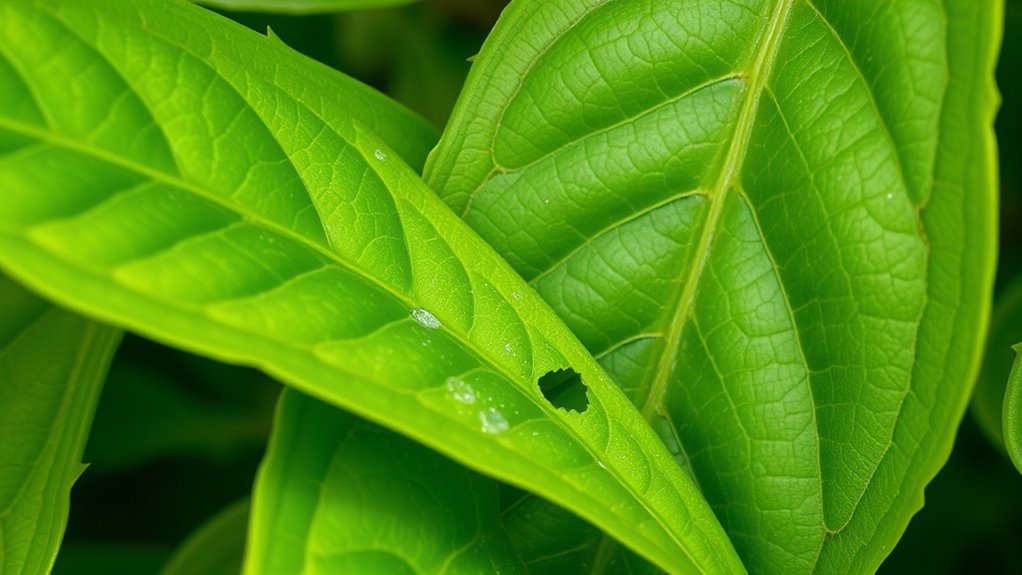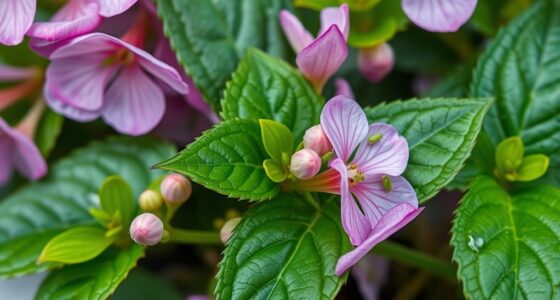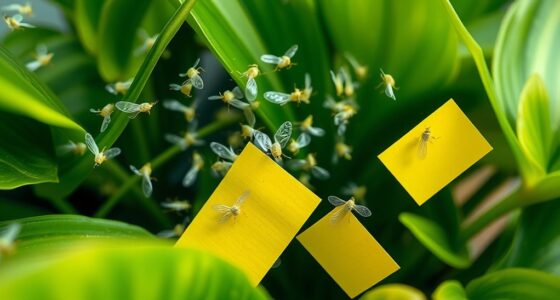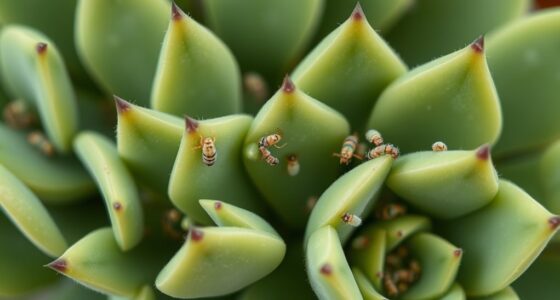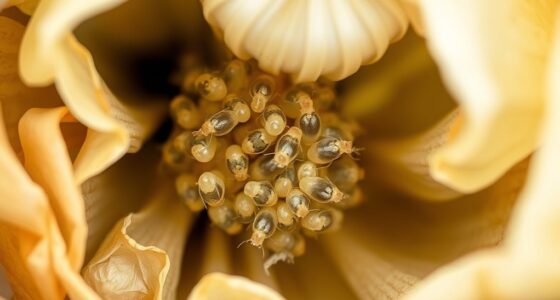If you notice silvery streaks, black specks of frass, or distorted leaves on your indoor plants, thrips might be the culprit. These tiny, slender insects hide on the undersides of leaves or within flower buds, causing visible damage as they feed. To control them naturally, isolate affected plants, wash leaves with water, or apply insecticidal soap and neem oil. Paying close attention to these signs helps prevent severe infestations—if you’d like, you’ll discover more effective strategies beyond just identifying these pests.
Key Takeaways
- Look for silvery streaks and black frass on undersides of leaves as signs of thrips damage.
- Deformed, speckled, or damaged leaves indicate possible thrips infestation.
- Early detection through regular inspection helps prevent severe foliage damage.
- Washing leaves with water and applying insecticidal soap or neem oil can control thrips naturally.
- Introducing natural predators and removing debris reduces hiding spots and supports pest management.
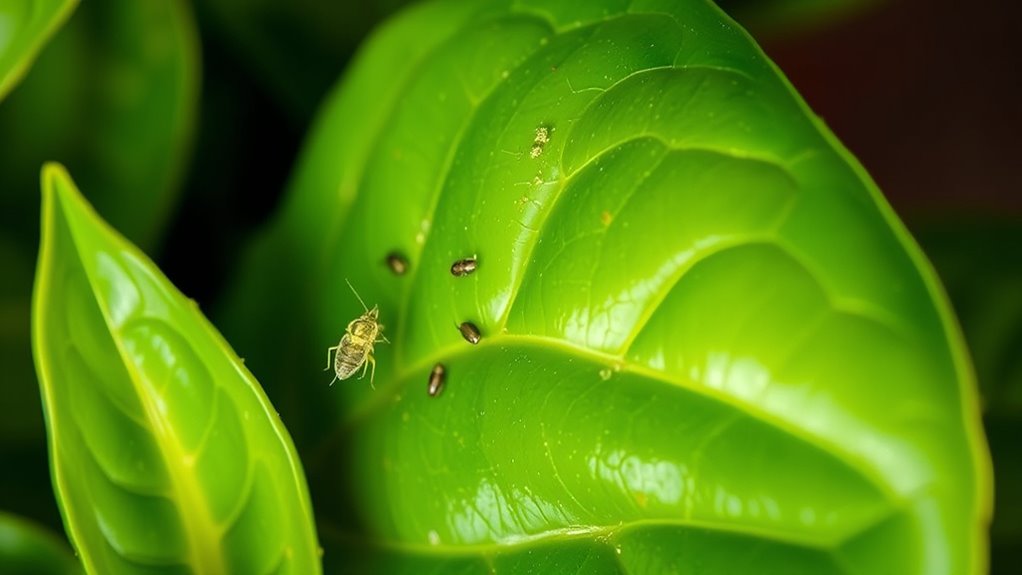
Ever wonder why your indoor foliage starts looking damaged despite your efforts? It’s frustrating to care for your plants and still see them withered, speckled, or deformed leaves. Often, the culprit is tiny pests that slip past your notice—thrips. These minuscule insects are notorious for causing visible damage to foliage, but identifying them early is key to managing the problem. Pest identification is a vital step here. Thrips are slender, elongated insects, usually just a few millimeters long, with fringed wings that give them a delicate appearance. They tend to hide on the undersides of leaves or within flower buds, making them hard to spot until damage becomes evident. You might notice silvery streaks, black specks of frass, or distorted leaves, which are telltale signs of thrips activity. Recognizing these symptoms and confirming pest presence allows you to act swiftly and avoid further damage. Regular monitoring and early detection play a crucial role in preventing severe infestations that could threaten your plant’s health.
Once you’ve identified thrips, it’s time to consider natural remedies that can help control their population without resorting to harsh chemicals. Many indoor gardeners prefer natural solutions to keep their environment safe and healthy. Start by isolating affected plants to prevent thrips from spreading to others. You can then try washing the foliage with a strong stream of water to dislodge the insects. This simple step often reduces their numbers considerably. Additionally, applying insecticidal soaps or neem oil can be very effective. These natural remedies coat the insects, interrupting their feeding and reproductive cycles without harming your plant or the environment. Make sure to thoroughly spray the undersides of leaves, where thrips tend to congregate. Repeat treatments every few days to ensure you’re knocking down the pest population. Introducing natural predators, like ladybugs or predatory mites, can also help keep thrips under control, especially if you prefer biological methods.
Monitoring your plants regularly will help you catch thrips early on, preventing extensive damage. Keep an eye out for new signs of distress on your foliage, and routinely inspect the undersides of leaves for tiny insects or their damage. Maintaining good plant hygiene—removing dead leaves and debris—reduces hiding spots for pests and supports overall plant health. Remember, the key to managing thrips damage on indoor foliage lies in early pest identification and applying natural remedies promptly. With patience and persistence, you can restore your plants’ health without relying on harmful chemicals, ensuring your indoor garden remains vibrant and thriving. Paying attention to pest signs and symptoms can make all the difference in maintaining healthy indoor plants.
Frequently Asked Questions
How Do Thrips Transmit Plant Diseases Indoors?
Thrips transmit plant diseases indoors through thrips disease transmission, where they carry indoor plant pathogens on their bodies and mouthparts. As they feed on your foliage, they inadvertently transfer these pathogens from infected plants to healthy ones. To prevent this, regularly inspect your indoor plants for thrips and remove infected foliage. Controlling thrips populations reduces the risk of disease spread and keeps your indoor garden healthy.
Can Thrips Infest Indoor Plants During Winter?
Yes, thrips can infest indoor plants during winter because many plants have reduced winter resilience, making them more susceptible to pests. You might notice thrips activity as they find indoor environments more hospitable when outdoor conditions are harsh. To protect your plants, regularly check for signs of infestation and maintain proper hygiene, ensuring your plants stay healthy and less attractive to these resilient pests during winter months.
Are There Natural Predators for Thrips Indoors?
You might think thrips are unbeatable invaders, but natural predators like predatory mites and minute pirate bugs can help you fight back. These beneficial insects are part of biological control, actively hunting and reducing thrips populations indoors. Introducing them to your plants creates a natural, eco-friendly defense, keeping your foliage healthy without harsh chemicals. With patience, you’ll see these predators effectively keep thrips at bay, restoring your indoor garden’s beauty.
How Long Does It Take to Eliminate Thrips Completely?
It can take several weeks to fully eliminate thrips indoors. You should combine biological control methods, like introducing natural predators, with chemical treatments for faster results. Consistently monitor your plants, reapply treatments as needed, and maintain good hygiene to prevent reinfestation. Patience is key, as complete eradication depends on the severity of the infestation and your diligence in applying these control measures.
Do Thrips Prefer Certain Indoor Plant Species Over Others?
Ever wonder if thrips have a favorite? They definitely do! Thrips prefer certain indoor plant species over others, especially those with tender, new growth and lighter foliage. You’ll notice they’re more drawn to plants like orchids, begonias, or impatiens. Recognizing thrips preference helps you protect your plants better, focusing treatment on the most attractive hosts first. Keep a close eye on susceptible species to prevent an infestation before it spreads.
Conclusion
Watch for the telltale signs of thrips lurking on your indoor plants, because what starts as tiny specks can quickly become a full-blown infestation. If you ignore the damage, your beautiful foliage might soon suffer more than just a few blemishes. Staying vigilant keeps your plants safe, but the real question is—are you prepared to catch the threat early? The next move could determine whether your indoor oasis thrives or withers away.
